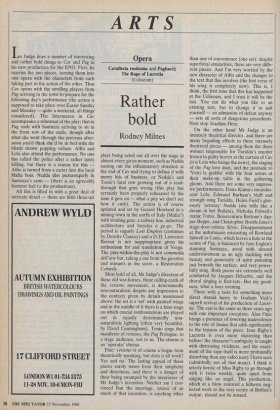ARTS
Ian Judge does a number of interesting and rather bold things to Cav and Pag in his new production for the ENO. First, he marries the two pieces, turning them into one opera with the characters from each taking part in the action of the other. Thus Cav opens with the strolling players from Pag arriving in the town to prepare for the following day's performance (the action is supposed to take place over Easter Sunday and Monday — quite a weekend, all things considered). The Intermezzo in Cav accompanies a rehearsal of the play; that in Pag ends with Santuzza arriving to sit in the front row of the stalls, though after what she went through the previous after- noon you'd think she'd be in bed with the blinds drawn popping valium. Alfio and Lola also attend the performance. No one has called the police after a rather nasty killing, but there is a reason for this Alfio is turned from a carter into the local Mafia boss. Nedda dies picturesquely in Santuzza's arms — (there is an agreeably feminist feel to the productions).
All this is filled in with a great deal of intricate detail — there are little three-act Opera Cavalleria rusticana and Pagliacci; The Rape of Lucretia (Coliseum)
Rather bold
Rodney Milnes
plays being acted out all over the stage at almost every given moment, such as Nedda sussing out the inflammatory situation at the end of Cav and trying to defuse it with merry bits of business, or Nedda's and Tonio's fatal row growing out of a read- through that goes wrong (this play has certainly been properly rehearsed by the time it gets on — what a pity we don't see how it ends). The action is of course updated and set by Gerard Howland in a mining town in the north of Italy (Mafia?) with winding gear, a railway line, industrial architecture and bicycles a go-go. The period is vaguely Lost Empires (costumes by Deirdre Clancey) and a D.H. Lawrence flavour is not inappropriate given his enthusiasm for and translation of Verga. The play-within-the-play is not commedia dell'arte but, taking a cue from the gavottes and minuets in the score, a Restoration Comedy.
Most bold of all, Mr Judge's direction of these old war-horses, these calling-cards of the verismo movement, is determinedly non-naturalistic despite any impression to the contrary given by details mentioned above: the set is a 'set' with painted wings and in the middle of it there is a false stage on which crucial confrontations are played out in equally determinedly non- naturalistic lighting (often very beautiful, by David Cunningham). Tonio sings that manifesto of verismo, the Pag Prologue, to a stage audience, not to us. The chorus is an 'operatic' chorus.
Fine: verismo is of course a bogus term theatrically speaking, but does it all work? Yes and no. The lasting appeal of these pieces surely stems from their simplicity and directness, and there is a danger of their being swamped by the luxuriance of Mr Judge's invention. Neither am I con- vinced that the marriage, source of so much of that invention, is anything other than one of convenience (one set): despite superficial similarities, these are very diffe- rent pieces. And I'm very worried by the new character of Alfio and the changes to the text that this involves (the first verse of his song is completely new). This is, I think, the first time that this has happened at the Coliseum, and I trust it will be the last. You can do what you like to an existing text, but to change it to suit yourself — an admission of defeat anyway — sets all sorts of dangerous precedents. Next stop Joachim Herz.
On the other hand Mr Judge is an intensely theatrical director, and there are many beguiling effects in these intensely theatrical pieces — among them the three women responsible for Turiddu's murder frozen in guilty horror at the curtain of Cav (it is Lola who brings the news), the staging of the Pag love duet, and the postlude to `Vesti la giubba' with the four actors at their make-up table in the gathering gloom. And there are some very impress- ive 'performances: Fiona Kimm's incandes- cent Lola, Edmund Barham's bluff and strongly sung Turiddu, Helen Field's glor- iously 'actressy' Nedda (she trills like a dream in her Ballata), Nicholas Folwell's manic Tonio, Bonaventura Bottone's dap- per Beppe, and Christopher Booth-Jones's stage-door-johnny Silvio. Disappointment at the unfortunate miscasting of Rowland Sidwell as Canio, which leaves a hole at the centre of Pag, is balanced by Jane Eaglen's stunning Santuzza, acted with shrewd understatement as an ugly duckling with beauty and generosity of spirit pulsating just beneath the surface, and very power- fully sung. Both pieces are extremely well conducted by Jacques Delaceite, and the choral singing is first-rate. But my good- ness, what a busy evening.
Those with a taste for something more direct should hurry to Graham Vick's superb revival of his production of Lucre- tia. The cast is the same as three years ago with one important exception: Alan Opie brings a presence of lowering malevolence to the role of Junius that adds significantly to the tension of the piece. Jean Rigby's Lucretia is even more shattering than before: the character's ambiguity is caught with distressing vividness, and the enact- ment of the rape itself is more profoundly disturbing than any video nasty I have seen (admittedly not all that many). I think it utterly heroic of Miss Rigby to go through with it twice weekly, quite apart from singing like an angel. This production, which at a blow restored a hitherto neg- lected work to the very centre of Britten's output, should not be missed.


































































 Previous page
Previous page